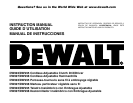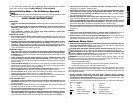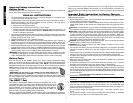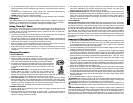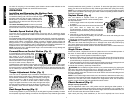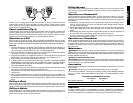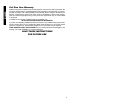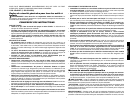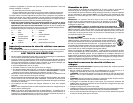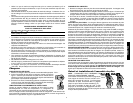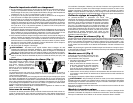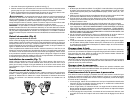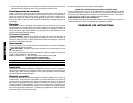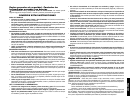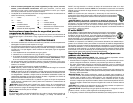
English
2
Important Safety Instructions for
Battery Packs
The battery pack is not fully charged out of the carton! First read the safety instructions
below. Then follow charging notes and procedures.
READ ALL INSTRUCTIONS.
•
Do not incinerate the battery pack even if it is severely damaged or is completely worn
out.The battery pack can explode in a fire.
• A small leakage of liquid from the battery pack cells may occur under extreme usage or
temperature conditions. This does not indicate a failure. However, if the outer seal is
broken and this leakage gets on your skin:
a. Wash quickly with soap and water.
b. Neutralize with a mild acid such as lemon juice or vinegar.
c. If battery liquid gets into your eyes, flush them with clean water for a minimum of 10
minutes and seek immediate medical attention. (Medical note: The liquid is 25-35%
solution of potassium hydroxide.)
• Do not carry extra battery packs in aprons, pockets, or tool boxes along with other metal
objects. Battery pack could be short circuited causing damage to the battery pack and
possibly causing severe burns or fire.
• Charge the battery packs only in D
E
WALT chargers.
• NOTE: The batteries in your battery pack are the nickel–cadmium type. Cadmium is
considered to be a toxic material by the Environmental Protection Agency. Before dis-
posing of damaged or worn out Nickel–Cadmium battery packs, check with your state
Environmental Protection Agency to find out about special restrictions on the disposal
of these battery packs or return them to a D
E
WALT certified service center for recycling.
•
DO NOT
store or use the tool and battery pack in locations where the temperature may
reach or exceed 105°F (such as outside sheds or metal buildings in summer).
DANGER: Never attempt to open the battery pack for any reason. If battery pack case
is cracked or damaged, do not insert into charger. Danger of electric shock or electro-
cution. Damaged battery packs should be returned to service center for recycling.
Battery Packs
Your tool uses an 18 Volt DEWALT battery pack. When ordering replacement battery
packs, be sure to include catalog number and voltage: Extended Run-Time battery packs
deliver 25% more run-time than standard battery packs. NOTE: Your tool will accept either
standard or Extended Run Time battery packs. However, be sure to select proper voltage.
NOTE: Battery storage and carrying caps are provided for use whenever
the battery is out of the tool or charger. Remove cap before placing battery in
charger or tool.
WARNING: Do not store or carry battery so that metal objects can
contact exposed battery terminals.
For example, do not place battery in
aprons, pockets, tool boxes, product kit boxes, drawers, etc. with loose nails, screws, keys,
etc. without battery cap. Without cap in place, battery could short circuit causing fire or
burns or damage to battery.
The RBRC™ Seal
The RBRC™ (Rechargeable Battery Recycling Corporation) Seal on the
nickel-cadmium battery (or battery pack) indicates that the costs to recycle
the battery (or battery pack) at the end of its useful life have already been
paid by D
EWALT. In some areas, it is illegal to place spent nickel-cadmium
batteries in the trash or municipal solid waste stream and the RBRC pro-
gram provides an environmentally conscious alternative.
RBRC in cooperation with D
EWALT and other battery users, has established programs in
the United States to facilitate the collection of spent nickel-cadmium batteries. Help protect
our environment and conserve natural resources by returning the spent nickel-cadmium
battery to an authorized D
EWALT service center or to your local retailer for recycling. You
may also contact your local recycling center for information on where to drop off the spent
battery.
Important Safety Instructions for Battery Chargers
SAVE THESE INSTRUCTIONS - This manual contains important safety instructions for
D
E
WALT battery chargers.
• Before using battery charger, read all instructions and cautionary markings on battery
charger, battery and product using battery.
• Do not operate power tools in explosive atmospheres, such as in the presence of flam-
mable liquids, gases, or dust. Power tools create sparks which may ignite the dust or
fumes.
CAUTION: To reduce the risk of injury, charge only D
E
WALT nickel cadmium recharge-
able batteries. Other types of batteries may burst causing personal injury and damage.
CAUTION: Under certain conditions, with the charger plugged in to the power supply,
the exposed charging contacts inside the charger can be shorted by foreign material.
Foreign materials of a conductive nature such as, but not limited to, steel wool,
aluminum foil, or any buildup of metallic particles should be kept away from charger cav-
ities. Always unplug the charger from the power supply when there is no battery pack
in the cavity. Unplug charger before attempting to clean.
DANGER: High voltage present at charging terminals. Do not probe with conductive
objects. Danger of electric shock or electrocution.
WARNING: Don’t allow any liquid to get inside charger or expose to rain or snow.
Electric shock may result.
• The charger and battery pack are specifically designed to work together. DO NOT
attempt to charge the battery pack with any chargers other than the ones in this
manual.
• These chargers are not intended for any uses other than charging DeWalt rechargeable
batteries. Any other uses may result in risk of fire, electric shock or electrocution.
• To reduce risk of damage to electric plug and cord, pull by plug rather than cord when
disconnecting charger.
• Make sure cord is located so that it will not be stepped on, tripped over, or otherwise
subjected to damage or stress.
• An extension cord should not be used unless absolutely necessary. Use of improper
extension cord could result in risk of fire, electric shock, or electrocution.
• An extension cord must have adequate wire size (AWG or American Wire Gauge) for
safety. The smaller the gauge number of the wire, the greater the capacity of the cable,
that is 16 gauge has more capacity than 18 gauge. When using more than one exten-
sion to make up the total length, be sure each individual extension contains at least the
minimum wire size.
Recommended Minimum AWG Size for Extension Cords
Total Extension Cord Length (feet)
25 50 75 100 125 150 175
Wire Gauge
18 18 16 16 14 14 12
• The charger is ventilated through slots in the top and the bottom of the housing. Do not
place any object on top of charger or place the charger on a soft surface that might
block the ventilation slots and result in excessive internal heat. Place the charger in a
position away from any heat source.
• Do not operate charger with damaged cord or plug — have them replaced imme-
diately.
• Do not operate charger if it has received a sharp blow, been dropped, or otherwise
damaged in any way; take it to an authorized service center.



